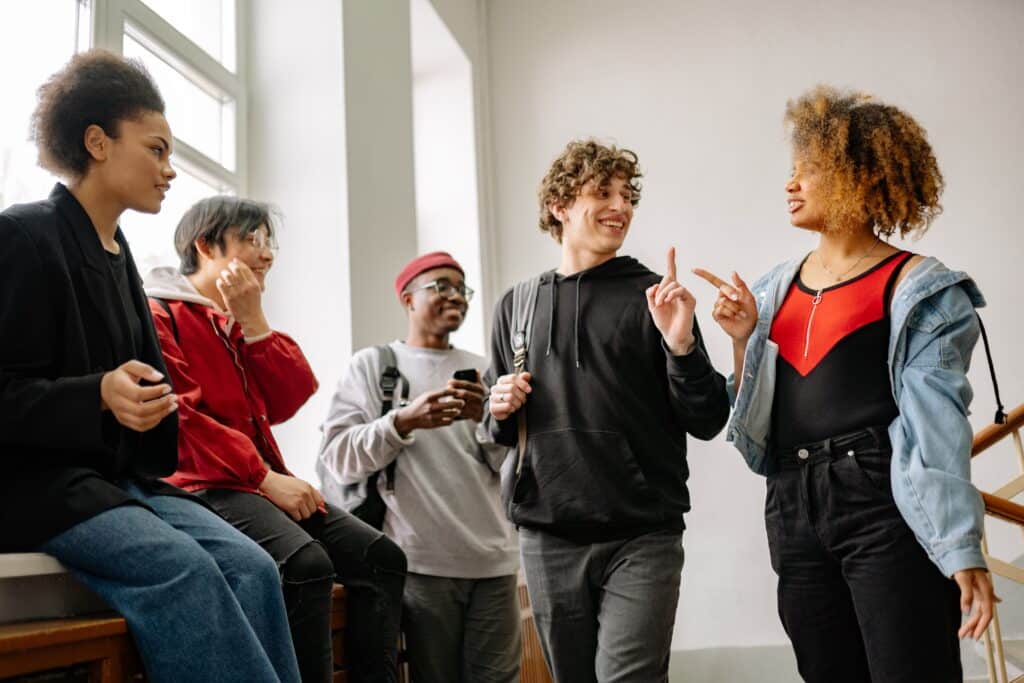
10 Speaking Strategies for ESL Students: Tips and Tricks to Get Students Talking in No Time
Getting students to talk is the name of the game for many ESL teachers. And I know from personal experience that sometimes this isn’t as easy as it seems.
Grammar drills, book exercises, flashcards and other traditional methods are useful, but can only get your students so far.
Eventually, they need to open their mouths and actually start speaking, communicating and making the language their own.
But sometimes they just don’t want to.
In this post, I’ll give you my top 10 own fail-proof strategies, tricks and tips to work into all your lessons to transform those shy observers into confident chatterboxes before your very eyes!
Contents
- 1. Pair Work Plus Feedback
- 2. Role Plays
- 3. Team Projects
- 4. Change Activities Up Often
- 5. Always Warm Up
- 6. Do Preparation Tasks for Homework
- 7. Learn Students’ Names
- 8. Be Approachable and Friendly
- 9. Build Confidence
- 10. Kindle the Fire
Download: This blog post is available as a convenient and portable PDF that you can take anywhere. Click here to get a copy. (Download)
1. Pair Work Plus Feedback

Whatever is terrifying alone becomes much less daunting in a pair.
First, there is less of the spotlight, because you and the rest of the class are not watching every person’s interactions. Everyone also has someone dedicated to giving them support, encouragement and direct feedback.
So, when you’ve got a conversation topic you’d like your students to tackle, start with pair work.
Get students to debate all questions or topics in pairs first. Not for long, just a few minutes.
Then have them share the results of their conversation with the whole group and build discussion on that. The magic is that, when you ask them in front of the whole class, they are already prepared. They do not have to think something up on the spot and they are not totally responsible for what they say, since it is the result of a joint effort. This takes away the sting of failure and the fear of speaking up.
Wander around between the pairs to interact, listen, question or correct, wherever you are needed. This is a lovely learning environment for the students because it feels informal and they can ask questions they might otherwise fear to ask when all eyes and ears are on them. They get to know and trust their peers better. And they get to talk to you on a more personal level. Just this alone puts them more at ease.
2. Role Plays

This gets students out of themselves and their inhibitions. It is also massively fun in my classroom experience.
To generate maximum confidence and facilitate speaking, it needs preparation first. A spontaneous role play can be beyond terrifying to many.
Give each person an easy role to follow. Here are some great examples. As you can see, each card has a few prompts to help students start thinking. The other partner plays the opposite role.
For less confident groups or just to ensure success, put people with the same role in pairs first, before the role play begins. This will give them a chance to run through some ideas with someone in the same situation and give them confidence they might lack if just thrown straight in.
Props are good. If you are a creative type then make some things yourself, bring in different hats or rearrange the room slightly to resemble a doctor’s surgery/home living room/whatever situation you are role playing. But don’t go too crazy. Just entering a role and using an imagined name is normally enough to suggest to the students that they are somehow outside themselves.
During the role play you can circle the room and listen in, have a joke and join in the fun. Try not to cramp their style by butting in or correcting too much. This is pure speaking and fluency. Accuracy can wait.
3. Team Projects

Group work within class works best if carefully structured. I like to set my students up with small team projects. For instance, “design a marketing strategy for an unpopular place in your country.” This task centers on the students’ creativity in thinking up their own ideas.
But it is also important to give them a structure to work around.
Write them a brief. Preferably type it up in advance. You can project it if you have a screen and monitor at your disposal. If not, write up a brief on the board and talk them through it.
For example, I got my students to watch this video on heritage tourism and then think of ways to market their own town based on heritage tourism. The brief was very clear: five pieces of information about the town, five ideas to remarket it. The result was a fabulous 90-minute lesson of student presentation, interaction and discussion.
These three strategies: pair work, role play and task briefs are, in my opinion, the foundation stones of useful speaking strategies. Here are some more general tips to make your speaking classes a sure-fire success.
4. Change Activities Up Often

You are trying to create an artificial English-speaking environment, a kind of bubble separate from the ordinary world of the dull classroom. For this you need to make each week different, to lure the students in, away from classic classroom passivity and boredom.
This does not mean massive amounts of extra work for you. Just vary the format each week.
Last week was very pair focused? Fine, today we will do a group task. Sometimes pair, sometimes group work, mingling, sometimes an article, song or short video. Sometimes book work and organized discussion, sometimes role play. It does not matter so much what you do as long as you vary it. Swap and switch partners and groups regularly.
Keep things fresh and unexpected.
5. Always Warm Up

Making it fun gets students involved!
Have an attractive “starter” for each lesson, a fun video or song to listen to and then gap-fill missing words. This makes the conversation topic interesting for the students and starts them making associations and discussion points. You would be amazed at the power and motivation a simple 5-minute introduction can bring to the whole 90 minutes.
Traditional discussion work from a textbook can be good too. It may be comforting for students who like a classical approach to study, but try and spice it up with extras and ideas of your own.
6. Do Preparation Tasks for Homework

Similar to pair work, getting students to do the groundwork before the main discussion begins is a great way to ensure they have plenty to say and the guts to say it!
I often give my students a topic and some short introductory reading. They then have to prepare specific answers to questions.
More generally, you can get them to find issues in the news that interest them for homework. Just make sure you tell them exactly what you want (for example, five facts, a brief history, etc.). It is vital they bring something concrete to throw into the class discussion. Again, this will be presented after preparation is complete, so students are well prepared and not put on the spot.
Get students to provide the content! It will then be much easier to encourage them to tear into it and get talking!
7. Learn Students’ Names

Do not underestimate the importance of addressing your students by name.
Asking questions to nobody in particular gets no particular response, except with chatty classes. When you ask someone personally to speak up, they will feel more motivated to answer.
Learning names always demonstrates a level of respect and interest in your students. Plus, once you have the name in place other facts tend to stick. Students will feel more acknowledged when you start saying things like “Stefan, you said that you used to be in the army, what do you think of what Marina has just said?” in place of “How about… you there… what do you think?”
Remember though, always make it okay to not answer. This stops students from stressing out after being called upon. If they are stumbling or short of words just thank them and pass to someone else. Give them a chance to speak a bit later.
8. Be Approachable and Friendly

Many students have commented that they felt comfortable to speak in my lessons because they knew they would not be laughed at or punished.
Remember, speaking can be a very difficult thing for many students. This is not just their English on the line but deeper fears of unworthiness or ridicule.
Be approachable and friendly. Make it okay not to answer and praise effort. Thank them for contributions throughout and at the end of each lesson.
9. Build Confidence

Whilst students want to improve, many have survived schooling systems where they were punished for every small error.
Create an adult environment where speaking is encouraged and mistakes are valued stepping stones towards improvement. Re-frame mistakes rather than correcting them. Repeat and affirm what they say in correct English, within the flow of conversation.
10. Kindle the Fire

Finally, do not expect the fire of conversation to erupt where you want or expect it to.
You cannot make students talk.
Learn to plan speaking sessions as a series of activities and opportunities carefully prepared to provide the sparks of discussion. Your job is to prepare the ground and then if discussion does kindle, fan the flames, take a step back and let it develop. Your students will thank you for providing the space to make this possible.
Remember what a gift you are giving students by setting them free to talk without fear of failure. Eventually, with any luck, your class will start gabbing away.
Remind them that this will help them in their language improvement more than anything else.
Download: This blog post is available as a convenient and portable PDF that you can take anywhere. Click here to get a copy. (Download)


